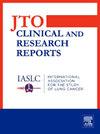IA期非小细胞肺癌肺叶切除术与节段切除术的隐匿淋巴结检测
IF 3.5
Q2 ONCOLOGY
引用次数: 0
摘要
目的除了对淋巴结实质边缘的讨论外,关于淋巴结清扫程度的资料很少,尤其是在节段性切除术中。本研究旨在探讨淋巴结清扫的程度和隐匿性疾病在节段切除与叶段切除的比较。方法对2012年至2022年接受T1N0M0(≤3cm)非小细胞肺癌节段切除术或肺叶切除术的患者进行单机构回顾性分析。比较两组淋巴结清扫程度和隐匿性淋巴结病变的检出率。将N1淋巴结进一步分为术中采集的标本(N1夹层)和病理学家从肺标本中取出的淋巴结(N1肺标本)。结果在研究期间,临床T1N0M0 NSCLC共行957例肺叶切除术和402例节段切除术。在肺叶切除术组中,ln的中位数明显更高(18个比12个;p & lt;0.001)。这种趋势在所有淋巴结组中都是相似的,包括N2淋巴结(7对5),N1淋巴结清扫(6对4),最显著的是N1肺标本淋巴结(4对0;所有p <;0.001) N1隐匿淋巴结有显著性差异(13.3% vs 3.7%;p & lt;0.001),而N2隐匿淋巴结差异不显著(5.5%对3.2%;P = 0.074)。结论节段切除术与淋巴结取样减少相关,这意味着N1淋巴结隐匿性转移的检出率较低。虽然标准化的病理解剖可以潜在地提高检测,但LN取样与节段切除术可能存在不可避免的劣势。本文章由计算机程序翻译,如有差异,请以英文原文为准。
Occult Node Detection With Lobectomy Versus Segmentectomy for Stage IA NSCLC
Objective
Besides the discussion on parenchymal margin, data on the extent of lymph node (LN) dissection are scarce, especially in segmentectomy. This study aimed to investigate the extent of LN dissection and detection of occult disease in segmentectomy compared with lobar resection.
Methods
We performed a single-institution, retrospective analysis for patients who underwent segmentectomy or lobectomy for clinical T1N0M0 (≤3 cm) NSCLC from 2012 to 2022. The extent of LN dissection and the rate of detection of occult LN disease were compared. N1 nodes were further classified as collected as a specimen during the operation (N1 dissection) and the nodes retrieved from lung specimens by pathologists (N1 lung specimen).
Results
During the study period, 957 lobectomies and 402 segmentectomies were performed for clinical T1N0M0 NSCLC. The median number of sampled LNs was significantly higher in the lobectomy group (18 versus 12; p < 0.001). This tendency was similar across all node groups, including N2 nodes (7 versus 5), N1 dissection nodes (6 versus 4), and most significantly N1 lung specimen nodes (4 versus 0; all p < 0.001) There was a significant difference in N1 occult nodes (13.3% versus 3.7%; p < 0.001), whereas the difference was not significant in N2 occult nodes (5.5% versus 3.2%; p = 0.074).
Conclusions
Segmentectomy was associated with less LN sampling, which translated into lower detection of occult nodal metastasis in N1 LNs. Although standardized pathologic dissection could potentially improve detection, there is likely an inevitable inferiority in LN sampling with segmentectomy.
求助全文
通过发布文献求助,成功后即可免费获取论文全文。
去求助
来源期刊

JTO Clinical and Research Reports
Medicine-Oncology
CiteScore
4.20
自引率
0.00%
发文量
145
审稿时长
19 weeks
 求助内容:
求助内容: 应助结果提醒方式:
应助结果提醒方式:


